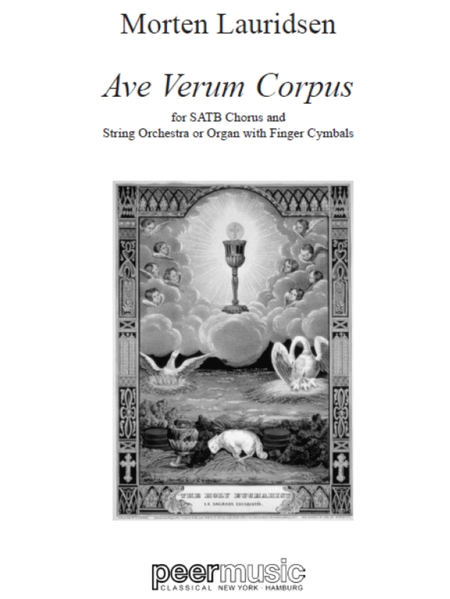Ave Verum Corpus
for SATB Chorus, String Orchestra (or Organ) & Finger Cymbals Piano Reduction
-
Ships in 24 hours
Details
Description
SKU: HL.1128588
For SATB Chorus, String Orchestra (or Organ) & Finger Cymbals Piano Reduction. Composed by Morten Lauridsen. Peermusic Classical. Chant. Octavo. 20 pages. Duration 630 seconds. Peermusic Classical #70357-121. Published by Peermusic Classical (HL.1128588).ISBN 9781705182772. UPC: 196288111733. 6.75x10.5x0.045 inches.
The newly released Ave Verum Corpus for choir, string orchestra or organ, with finger cymbals joins a catalog of works that are performed throughout the world, with several recordings that received Grammy nominations. Ave Verum Corpus for choir and string orchestra or organ was commissioned by Wheaton College to inaugurate its new Armerding Center for Music and the Arts, named for Hudson Armerding who served as the fifth president of Wheaton College from 1965 to 1982 and his wife, Miriam, who received a music degree from Wheaton. Notes from the Composer: The newly composed antiphon should be performed as one would a traditional Gregorian chant. The set of finger cymbals should be played by a member of the bass section who will hold one in each hand and strike the two together on the edge. Use only high-quality cymbals, not the tinny, cheap ones found on the internet used mainly by belly dancers. I recommend those manufactured by Toca or Zildjian. I prefer this work to be accompanied by a full string orchestra, as recorded by the Wheaton College choir and orchestra conducted by John Trotter. If a string orchestra is not possible, it may be performed with organ, registration ad libitum (or, finally, with piano if an organ is not available). The duration of the piece is 10:30. Organists will use the piano accompaniment as a template and are free to use their own registrations throughout (a more subdued, intimate registration should be employed at rehearsal D and full organ at rehearsal F plus the ending).

 Share
Share